|

This account is dedicated to the memory and family of Dennis Harding who, on the same day I was having the experience of my life, lost his in the same pursuit.
- Jerome Hamlin
"I have seen the gods!"
A Descent to Cave 4
In November 2000, Dinofish.com creator, Jerome Hamlin, became one of the first non-scientists to view coelacanths swimming in their natural habitat. Here is his first hand account of a dive in the Jago submersible to coelacanth Cave 4 in the Comoro Islands.
Mon, Nov 27, 2000
Aboard the Indian Ocean Explorer off the southwest coast of Grand Comoro Island, I'd just learned from Hans Fricke that I'd be making a dive in the Jago submersible to view coelacanths at depth in their natural habitat. This was a dream I'd harbored for more than a decade, since the Fricke Dive Group first filmed them here in 1986. Coincidentally, this would also be the day that a newly discovered cluster of coelacanths would first be filmed off the South African coast thousands of miles away at Sodwana Bay. Research associate, Karen Hissman came into the salon and said I would have to take a shower and put on clean clothes because of the close quarters. Good idea. Mine reeked from tropical sweat and grime. I would also have to be weighed for ballast adjustment. Hans showed me to cabin 4. Karen brought in a bathroom scale, which I stood on. I showered and put on a T-shirt and bathing trunks that she had left. Then I went back up to the salon and talked with Hans. He had finished his dives for this season. The local population had been recounted, and tissue samples taken with a probe. In a couple of days they would leave. David Royat, the ship's operator-in-chief came in and gave me a pre-dive briefing. I would get in the sub on board the boat with Jurgen Schauer, the sub's designer-builder, chief engineer, and pilot. We would be lowered into the water by the Explorer's stern mounted crane. The sub would then be towed to the dive location by one of the two ship's Zodiacs. A diver would disconnect the towline and we would begin our descent.
Karen came into the salon and said they were ready. I went to the stern as Jago's tie down straps were being disconnected. While we were standing about the tiny sub Jurgen sneezed, and I kidded, "Hey, none of that, we will be in close quarters." He nodded, and then added only half joking, "And no farting either!" Jurgen had me climb up the back railing. At my request Hans began filming with my camera. Karen asked me to remove my sandals when I was on one of the two standing platforms on either side of the hatch. I had just the T-shirt and a baggy bathing suit on as I climbed down the hatch tube. I was almost naked, but so psyched I didn't care how I looked. I sat on the platform in front with Jurgen behind, operating the controls. Jurgen offered me a small cushion to sit on.
The first thing I asked Jurgen about was how to bring the sub up in case something happened to him. Jurgen showed me how to blow the ballast and begin Jago's ascent. Once on the surface an additional lever had to be turned to stabilize the craft. Jurgen reassured me I would not be the one using the procedures. The crane began to lift us. We rose above the deck in the manner of a Ferris Wheel cab when people are being loaded in other cabs and your seat rises slowly in steps. I peered out the one front window, a semi-spherical bubble a couple of feet in front of me, at the others on deck. The view was clear. There was no wide-angle lens effect, but possibly distance and size distortion, particularly at the edges. We swung out over the water and were lowered down until, with a gentle sloshing, the bubble was underwater, a bright blue-green in front of me, while just behind my head and above us the top hatch bubble was in daylight. We rocked gently in the swell. It must have been 3:30 or 4:00 in the afternoon. Jurgen said this was Jago dive number 725. The first two test dives had been in Lake Geneva, Switzerland.
From the swirl and motor noises you could tell we were under tow. This lasted only a few minutes. Suddenly, a black body in shorts, surrounded by a cloud of bubbles, plunged like a dagger thrust in front of the window. The sudden disruption of the serene view was startling. A boy had dived in from the Zodiac to release the towrope. Jurgen began to flood the two ballast cylinders underneath the submersible's cabin pod. Slowly, slowly we settled lower in the water, the top bubble eventually showing a water line. It seemed as if the sub did not want to go down.
After five minutes the top hatch bubble covered over with water and we began a slow descent.
|
|
I couldn't help thinking that more people have been to outer space than have gone down to see coelacanths. Inside the cannonball-shaped passenger pod was an array of instrumentation surrounding us on the sides. This was not an integration of very hi-tech stuff, more a collection of devices from different sources that Jurgen had installed, probably one at a time, saying: "Now I have the depth meter working, Now the thruster control box", and so on. Certainly an ad hoc array. The depth meter readout was a red LED display to my left. There was a time clock, and a ten-year-old Lowrance X-16 sonar unit for bottom finding. A small air scrubber was next to Jurgen. The thruster controls were switches on a small hand-held box with a cable running out the back. It was Radio Shack upgraded to Mercedes standards. Even the external manipulator arm had a mechanical linkage to a handle inside. The linkage went through a pressure tight port about 3 inches in diameter just next to my right knee. By my left was a similar but unused port with an inscription on it in plastic labeling tape: "For Lords and Ladies Only". I had to double check that this was a joke. It was; there are no onboard facilities. A plastic electric blower fan whirled a few inches from my face. I found it quite a relief to direct it right at myself. Without the fan there was a heaviness to the air that could have triggered a claustrophobic response. The curved sidewalls were still damp with condensation from the morning dive. We sat on our cushions on rubberized mats covered with a texture of small round knobs. The whole interior was scarcely larger than the cabin of a one man Mercury spacecraft, about the volume of a telephone booth.
The interior of the cabin remained lit by daylight as we went down, slowly dimming at the same rate the eyes adjusted. It never went completely dark, nor did Jurgen bother much with the interior lights. They would just confound the viewing outside.
|
As we slowly sank, Jurgen put a New Age music tape into a cassette player. |
|
 |
At first this seemed corny, but I soon got into the mood and I wanted my dive to be just like theirs. Karen's voice checked in from time to time on the ultrasonic transmission system. Picked up by the Jago's hydrophone it sounded like an effect on the music's soundtrack, a cross between a whale's song and the Beetle's commentary in Yellow Submarine. "How's Jerry?" she queried. Jurgen answered back, loudly, "We are ok. We are relaxed here." They must have been concerned that I was freaking out in the confined space. But I was too focused on "the mission" to be concerned about myself. Jurgen gave periodic depth readings as we sank, perhaps as much so as to indicate that he was conscious and alert. The sub was equipped with a "dead man's button" which had to be pressed once every ten minutes to avoid an automatic surfacing procedure - the fear was of unconsciousness due to oxygen deprivation. Back on the Indian Ocean Explorer, the sub's progress was tracked on a laptop computer with software that was part of an acoustical locating system, a package that the Jago team brought aboard the mother ship.
| "60 Meters", Jurgen announced, reading the LED display next to my head. Outside, light began to change color. |
|
 |
The light blue green was gone. A deep indigo set in. Millions of bits of debris were visible in the water column, like house dust blown from a leaky vacuum cleaner. This is the constant rain of planktonic detritus that feeds the bottom dwellers. A shape appeared in the distance out the front bubble and was moving closer. I saw quickly that it was a ray.
| |
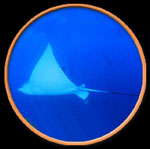 |
|
"A manta ray!", exclaimed Jurgen. |
It flew by the side of the sub, then reappeared coming towards us again. Unsure of the size distortions from the curved bubble window, I had no idea how large it was. What if it was huge and bumped us? Would there be damage? Jurgen later said the ray was about a meter across.
| We were alone again in the water column, sinking slowly. "150 meters", Jurgen spoke into a microphone. |
|
 |
I chatted with Jurgen much of the time. Hans checked in to talk to me and I answered that we were doing well. During silences, there was the New Age background music playing as a soundtrack to our descent. Of course, without visual references there was no sensation of movement. But then I saw something while looking down. Dark lines separated by white stripes. Very dim. It was the bottom! But how far away? What was the scale? It could have been three feet away or 150 feet. In a few minutes we gently touched bottom like a well-practiced lunar landing.
Our depth was 194 meters.
(640 feet) |
|
 |
I was surprised to find a flat bottom here after all the talk of a 45-degree slope. Perhaps it was a sandy platform. Now Jurgen began operating thrusters and turning the outside lights on and off. We rotated and bumped along until we came upon a formation of what looked like brown rock. The color was from algae.
| Whether the formation was coral or lava was not evident, but from the depth I assumed it to be lava. |
|
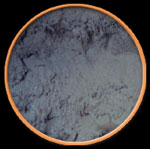 |
I was looking at a wall of this brown stuff, which seemed to be just in front of the bubble window a couple of feet away. There were some tiny fishes and incrustations. Then Jurgen said, "There is the cave, are there any coelacanths?" But where was the damn cave? All I saw was the brown wall! This was supposed to be what the group calls Cave 4. Like the tombs in the Valley of the Kings each coelacanth cave has a number designation, though the fishes in question make the pharaohs' mummies seem like Johnny-come-latelies. But I couldn't see the cave and Jurgen, sitting behind me, was hardly in a position to point to it. Then, lowering my head and looking along the top arc of the window, I saw that the brown wall receded. I twisted round on my side to get my head even lower, looking up. "There are no coelacanths," said Jurgen in his good German English, but he seemed to be asking a question.
I was now looking into a jagged slit in the rock.
It looked like a small hole a few feet across and about two feet in front of the bubble. I saw schools of small fishes, and what looked like solitary wrasses picking at the algae.
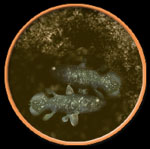 |
|
Then, in the same place, but better camouflaged, two coelacanths overlapping each other! |
I was startled. They seemed to be about seven inches long each. The fish were sideways to me, head to tail. At each end of the assemblage, a fiery golden eye blazed at me- the tapita cells in the back of the retina reflecting Jago's lights. "Yes," I said, "I see two in there. They look very small." "No, no, they are big," assured Jurgen. "They are 4 or 5 meters away!" The optical illusion was that they looked close and small. The sub was sticking its bubble and lights into the cave opening from below and could go no further.
When I was a kid, I went to a Christmas display at a department store. You looked into a dollhouse and there you saw Santa going about his business wrapping presents. The odd thing was the little red figure was a real person. It was all done with mirrors and lenses with the full size Santa in a room nearby. So now I looked into the coelacanth dollhouse. There was a clarity of image not captured on film or video. The fish hovered like suspended jewels. They had no startle response to the sub's lights, but they did slowly turn away until their tails were facing us. I noticed that one of them was missing the famous third epicaudal fin on its tail. "Yes, we know that one," said Jurgen. Now slowly again they turned back. On each fish, nine fins- eight for the one with the missing epicaudal- were operating in a complex, coordinated rhythm. The body of the fish is like a great dirigible with positioning fins instead of propellers. The two paired pectoral fins paddle in alternation to the two paired pelvic fins- the famous pre-adaptation to land tetrapod locomotion. The first dorsal rises and folds periodically. The second dorsal fin and the anal fin wave from side to side, while the tail fin curves slowly to this side or that and the epicaudal also flicks from side to side possibly detecting current shifts. A coelacanth ballet! Jurgen now appropriately accented this evolutionary dance with a Pink Floyd concert tape.
The cave darkened at the rear, but about 97 percent seemed visible. There were no juveniles in the rear, however, as proposed by some researchers. The entrance and walls of the cave had white encrustations of oyster shells and other materials that were mimicked by the patterns on the coelacanths, one of which was massively freckled with white marks, while the other had only a few. The fish were a dark blue black in the sub lights, and depending which set of lights were on and from which angle they were hitting, the eyes changed from bright gold to ice blue white to pure white. Creatures that see well in low light like cats and crocodiles also have this tapita reflectance. They shifted their positions, but did no head stands as coelacanths were once reported to perform. Jurgen now attributes the headstands to a reaction to electro- magnetic field leakage from their first submersible, the Geo. Jago is an electrically tighter ship. I told Jurgen I felt like a child hiding under a bed watching something I wasn't supposed to- peeking voyeuristically into another world, not a sexual world, but into someone else's existence. One of the fish turned toward me head on, both eyes glowing at once. As beautiful in its complexity of form as the coelacanth is in profile, when it turns head on there is an element of ugliness that has damaged its reputation and led to its being called "a beast." Teeth seem to be growing in all parts of the mouth- an orthodontist's nightmare (or delight!), and a curve of the mouth line gives an impression of permanent disapproval, a frown, from an anthropocentric perspective.
| Were it not for this front on aspect, the coelacanth would be recognized as one of the great beauties of the sea. |
|
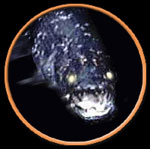 |
The fish I was now looking at was wide bodied like a jumbo jet, and I knew that from overhead these creatures look like salamanders. Swarms of small fishes swam round them with impunity. Jurgen said that only on two occasions did they see feeding behavior within the caves and on those occasions the small fishes may have been frenzied by the sub's lights causing movements that triggered feeding behavior in the coelacanths. In fact, what Jurgen complained about was a lack of behavior of the coelacanths they observed in the caves, no aggression, no feeding, and no spawning, just swimming in place. But at about five thirty every evening the fish in the caves would come out and descend the marine slopes to unknown destinies below. Early in the morning they would return. Jurgen hoped that the use of a low light camera within the caves might reveal more, with the subs lights turned off.
Behind me, Jurgen, the proficient D.J., was changing tapes, the only familiar sound I heard on the dive. Then he took out a still camera and a digital video camera and began filming. A slight current consistently rotated Jago to the right causing the coelacanths to disappear off stage left. Jurgen would then reorient us with a blast of the opposing thruster- small externally mounted electric motors with propellers, much like the lower units of trolling motors. By now I had dropped off the rubberized platform and contorted myself into a fetal position along the metal interior ringing the window, the better to look up and out. I felt like the fetus at the end of the movie '2001: A Space Odyssey ', which gazes at the earth with fresh eyes waiting to be reborn.
Jurgen lifted the sub for a minute to show me the seascape above the cave. This was a ridge with darkness beyond. A lone tubeworm projected above the ridge on one side, it's fan open to collect plankton. We watched and watched the coelacanths for well over an hour, every movement and readjustment, never bored with their lifelong dance of fins. Now we chattered and chirped like aliens viewing humans from a UFO. Although Jurgen had viewed coelacanths hundreds of times by now, and they were totally routine, he said he felt something of his original enthusiasm return for the moment.
Jurgen mumbled something about a line from the film "Titanic", taking one last long good look. I took the look, but then we stayed even longer. The coelacanths marked their endless eons paddling in the cave. They were almost biologically pre-positioned to come ashore. Why hadn't they evolved along that path? Well, they had changed physically over time more than most people realize. But they had found a niche without competitors and so perhaps without selective pressures to adapt further remained the same. That might be the explanation. Finally, eyes still glued to the scene, we backed off.
Then Jurgen switched off the lights, blew some ballast water from the tanks and the slow ascent began. We rose through thousands of bubbles released by Jago that climbed to the surface more slowly than us. Jurgen read off the depth meter reports. I eased away from the window, my mind blown out, something twisted a notch in the back of my brain, on a high that would last for several days. I had seen the gods! For me the viewing had been quasi-mystical, perhaps a feature of its novelty. Remember how the Apollo 8 astronauts had read from the Bible on the first lunar circumnavigation? Then the Apollo 11 astronauts had described a "magnificent desolation," and finally the Apollo 14 astronauts hit golf balls on the moon! I had the impression that Hans, Karen, and Jurgen were well past the golf ball stage.
| I was still reading from the Book of Genesis or was it The Origin of Species?
~ Jerome Hamlin
| |
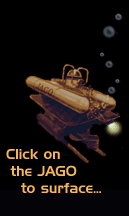 |
|
|

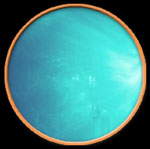
![]()
![]()

![]()




